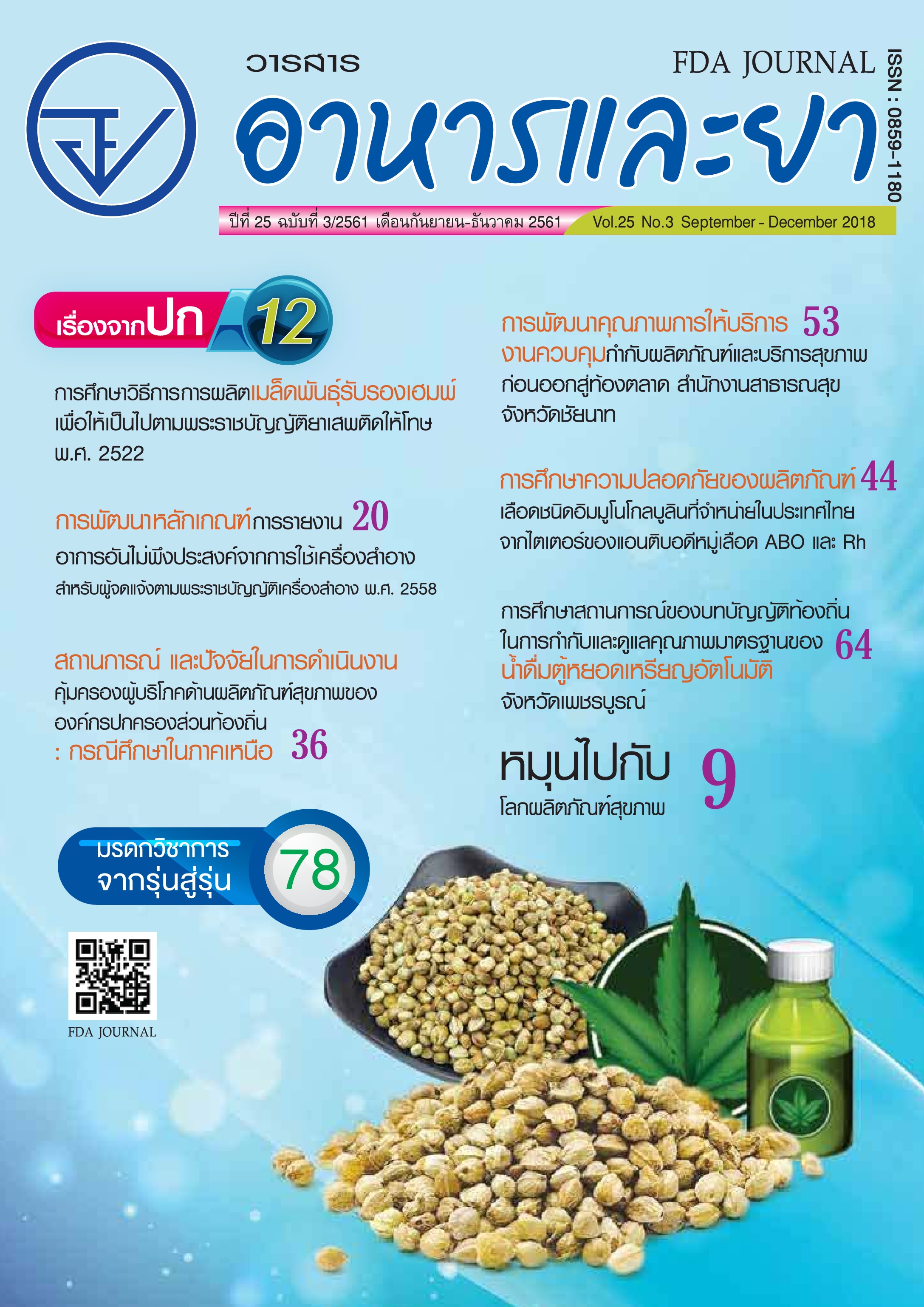การศึกษาความปลอดภัยของผลิตภัณฑ์เลือดชนิดอิมมูโนโกลบูลินที่จำหน่ายในประเทศไทยจากไตเตอร์ของแอนติบอดีหมู่เลือด ABO และ Rh
Main Article Content
บทคัดย่อ
ผลิตภัณฑ์อิมมูโนโกลบูลินที่ให้ทางหลอดเลือดดำ (Intravenous immunoglobulin; IVIG) เป็นหนึ่งในผลิตภัณฑ์เลือดที่ผลิตจากการแยกพลาสมาของคนด้วยขบวนการ Cohn-fractionation สำหรับรักษาโรคที่ต้องการ passive immunity อย่างไม่จำเพาะเจาะจง ซึ่งพลาสมาของผู้บริจาคมีหมู่เลือดหลัก คือ ABO และ Rh ทำให้ผลิตภัณฑ์ IVIG มีแอนติบอดี A/B (แอนติบอดีต่อหมู่เลือด ABO) และ D (แอนติบอดีต่อหมู่เลือด Rh) เหลืออยู่ปริมาณหนึ่ง โดยอาจเป็นอันตรายต่อผู้ป่วยได้ ตำราฟาร์มาโคเปียของสหภาพยุโรป 9.0 ได้กำหนดเกณฑ์ที่ไม่ก่อให้เกิดอันตรายต่อผู้ได้รับยาเมื่อเทียบจากปริมาณโปรตีนของยา 25 กรัมต่อลิตร คือ anti-A/B ต้องมีค่าไตเตอร์น้อยกว่าหรือเท่ากับ 1:64 และ anti-D ต้องมีค่าไตเตอร์น้อยกว่า 1:8 จากการตรวจวิเคราะห์ไตเตอร์ของ anti-A/B และ anti-D ด้วยวิธี direct haemagglutination ในผลิตภัณฑ์ IVIG จำนวน 6 ยี่ห้อ รวม 54 รุ่น ซึ่งเป็นตัวอย่างจากผลิตภัณฑ์ทั้งหมดที่มีจำหน่ายในปี พ.ศ. 2558-2559 และยังไม่หมดอายุในปี พ.ศ. 2560 พบว่าผลิตภัณฑ์ส่วนใหญ่มีแอนติบอดี A/B อยู่ระหว่างไตเตอร์ 1:4 ถึง 1:16 และส่วนใหญ่ไม่พบแอนติบอดี D ในผลิตภัณฑ์ ซึ่งอยู่ในเกณฑ์มาตรฐานที่กำหนด แสดงถึงผลิตภัณฑ์เลือดชนิดอิมมูโนโกลบูลินที่จำหน่ายในช่วงเวลาดังกล่าวมีความปลอดภัยต่อผู้ใช้
Article Details

อนุญาตภายใต้เงื่อนไข Creative Commons Attribution-NonCommercial-NoDerivatives 4.0 International License.
เอกสารอ้างอิง
2.คณะอนุกรรมการพัฒนาบัญชียาหลักแห่งชาติ. (2553). Human normal immunoglobulin, intravenous (IVIG). ใน คู่มือการใช้ยาอย่างสมเหตุผล ตามบัญชียาหลักแห่งชาติ บัญชี จ(2), หน้า 41-54. กรุงเทพฯ: สำนักงานประสานการพัฒนาบัญชียาหลักแห่งชาติ กองควบคุมยา สำนักงานคณะกรรมการอาหารและยา.
3.Jolles, S., Sewell, W.A.C & Misbah, S.A. Clinical uses of intravenous immunoglobulin. (2005). Clinical &Experimental Immunology, 142, 1–11.
4.Mohamed, M. Intravenous immunoglobulin-associated hemolysis: risk factor, challenges, and solutions. (2016). International Journal of Clinical Transfusion Medicine, 4, 121-131.
5.Thomas, M.J., Misbah, S.A., Chapel, H.M., Jones, M., Elrington, G. & Newsom-Davis, J. (1993). Hemolysis after high-dose intravenous Ig. Blood, 82, 3789.
6.Kahwaji, J., Barker, E., Pepkowitz, S., Klapper, E., Villicana, R., Peng, A., et al. (2009). Acute Hemolysis After High-Dose Intravenous Immunoglobulin Therapy in Highly HLA Sensitized Patients. Clinical Journal of American Society of Nephrology, 4(12), 1993-1997.
7.Duhem, C., Dicato, M.A. & Ries, F. Side-effects of intravenous immune globulins. (1994). Clinical & Experimental Immunology, 97(Supplement 1), 79-83.
8.Daw, Z., Padmore, R., Neurath, D., Cober, N., Tokessy, M., Desjardins, D., et. Al. (2008). Hemolytic transfusion reactions after administration of intravenous immune (gamma) globulin: a case series analysis. Transfusion, 48, 1598-1601.
9.Desborough, M.J., Miller, J., Thorpe, S.J., Murphy, M.F., & Misbah, S.A. (2014). Intravenous immunoglobulin-induced haemolysis: a case report and review of the literature. Transfusion Medicine, 24, 219–226.
10.Thorpe, S.J., Fox, B.J., Dolman, C.D., Lawrence, J. & Thorpe, R. (2003). Batches of intravenous immunoglobulin associated with adverse reactions in recipients contain atypically high anti-Rh D activity. Vox Sanguinis, 85, 80-84.
11.ศูนย์เฝ้าระวังความปลอดภัยด้านผลิตภัณฑ์สุขภาพ กองแผนงานและวิชาการ สำนักงานคณะกรรมการอาหารและยา. Intravenous Immunoglobulin (IVIG) กับการเกิดภาวะ autoantibody response. จดหมายข่าว HPVC safety news [ออนไลน์]. เข้าถึงเมื่อ 12 ธันวาคม 2560. จาก: https://thaihpvc. fda.moph.go.th/thaihvc/Public/News/uploads/hpvc_2_5_0_100477.pdf
12.European Directorate for the Quality of Medicines and Healthcare (EDQM). (2017). Human normal immunoglobulin for intravenous administration. In European Pharmacopoeia 9.0, page 2687-2689. Nördlingen: Druckerei C.H. Beck.
13.European Directorate for the Quality of Medicines and Healthcare (EDQM). (2017). 2.6.20 Anti-A and Anti-B haemagglutinins. In European Pharmacopoeia 9.0, page 213-214. Nördlingen: Druckerei C.H. Beck.


